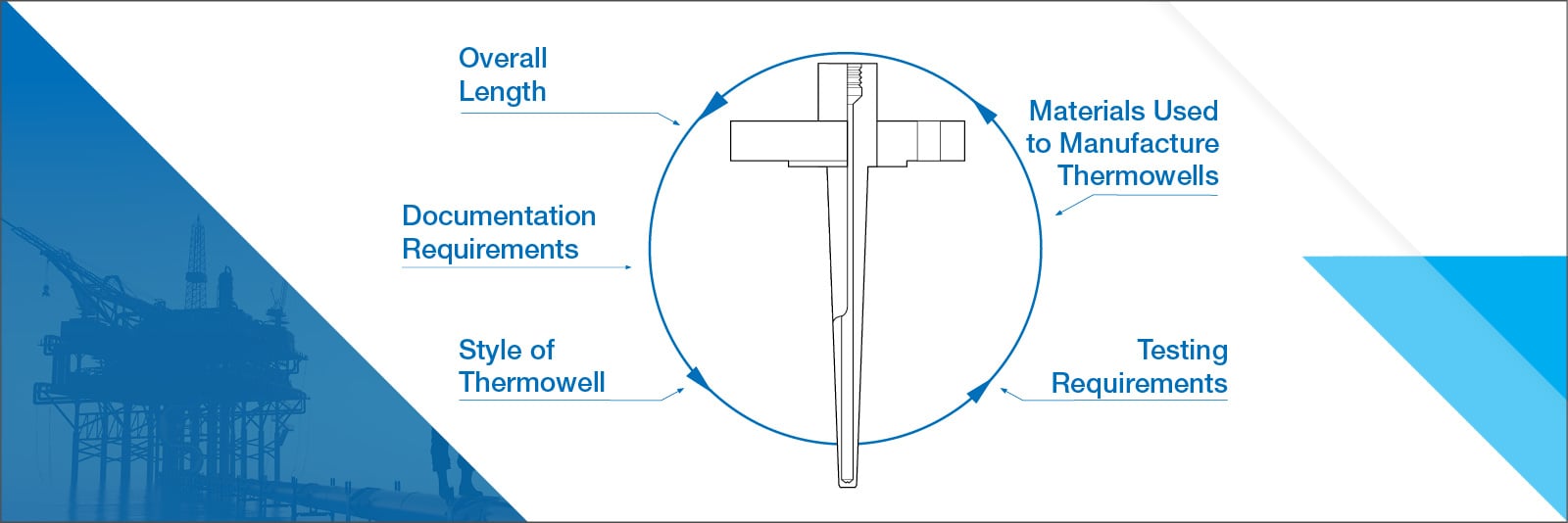How Much Do Thermowells Cost? 5 Factors that Influence Price
This article was originally published on May 8, 2021, and was updated on February 5, 2025.
There are many different styles of thermowells, so depending on what you need, the cost for these instruments can be as low as $15 or as high as $5,000. With such a broad price range, selecting the right one for your application can be difficult.
Ashcroft is a leader in pressure and temperature instrumentation. In my role as an engineer and product leader at the company, I have insight into the factors that can affect a thermowell's cost and what to consider before you place an order.
Read this article to learn about the price ranges of thermowells and the key cost drivers, including product design, materials, testing requirements and more. You will also receive links to additional resources to help deepen your knowledge about the temperature instruments we offer.
Please note: the costs represented in this article depend on the material, the requirements/tests needed, and the process conditions involved.
Top 5 Thermowell Cost Drivers
1. Thermowell type
The style of thermowell you choose plays a big part in the cost. There are five different thermowell types, each with a different price range:
- Threaded: $15 - $500
Threaded thermowell process connections are the most common and least costly of all the thermowell designs. They are ideal for lower pressures where ½-inch NPT or 1-inch NPT are standards. - Socket Weld/Weld-In: $45 - $600
A pipe attachment detail in which the thermowell will be inserted a pipe is inserted into a recessed area of a valve or fitting and welded in place. Socket Weld thermowell fittings are mainly used for small pipe diameters, so sizes 1 inch and smaller are the most common. - Sanitary: $95 - $500
While a sanitary thermowell also has smaller process connection sizes, it is a bit more costly due to the requirements for use in sanitary applications. Sanitary thermowells have a tri-clamp connection and smooth finish (32 Ra or better) to allow for easy cleaning as not to contaminate the process. There is an additional cost due to manufacturing requirements. - Flange: $125 - $2,000
Piping requirements may necessitate a flanged thermowell to be attached to the piping. In this case, the flange is welded to the solid bar stock shank. The flange material adds additional cost and is subject to the same raw material source and availability described earlier. Flanges come in different styles and carry class ratings of 150, 300, 600, 900, 1500 and 2500. Each has a different rating and thickness based on process pressure and piping requirements. - Vortex: $900 - $5,000
This is the most expensive thermowell style. It’s required for process conditions with extreme pressures and process flow. A vortex thermowell is designed to withstand applications that Standard Flange Thermowells are not to be used by ASME PTC 19.3 TW-2016.
The chart below highlights the common applications for each type of thermowell and the benefits of each.
Figure 1. Thermowell types.

2. Thermowell length
The length of a thermowell also influences its cost. For instance, a 4-inch thermowell for limited space can cost as little as $30. On the other hand, longer thermowells need more raw materials, leading to higher costs. Additionally, thermowells exceeding 25 inches cannot be machined from solid bar stock, so welding will be needed, which raises the cost further.
3. Thermowell material
Thermowells can be made with a variety of materials. The most common include brass, 304 Stainless Steel, 316 Stainless Steel, and various grades of Carbon Steel. Hastelloy® B, Hastelloy® C, Nickel, Tantalum (sheath) and Titanium.
Exotic materials, such as Titanium or Hastelloy® B or Hastelloy® C material may be required for their superior resistance to corrosive environments. Because these materials are not as readily available from all suppliers, they carry a higher raw material cost.
The country of origin of the raw material also has an impact on the overall thermowell cost. Materials sourced from China or India are more accessible, which could result in cost savings. However, specific project or system requirements may impose restrictions on the country of origin if their quality standards for materials are not as high as North America and Western Europe. When materials are not as readily available there is a higher sourcing cost.
4. Thermowell testing requirements
Some manufacturers offer testing options for thermowells, which increase costs. These extra costs can match or exceed the thermowell's base price. Many tests are standard and done in-house, but some need third-party due to special requirements. Wake frequency calculations are perhaps the most common testing requirement and typically follow ASME PTC19.3 TW-2016 standards.
Other tests like hydrostatic and dye penetrant inspections (for flanged thermowells) can also be done, but some more complex tests may need third-party assistance. For instance, X-ray and Ultrasonic analysis of flange welds are expensive and require an accredited third-party facility to conduct these tests. It's common for a thermowell to need seven or eight different tests based on project needs. Ashcroft offers over 20 additional tests, including MTRs, PMI, Dye Pen, External Hydro Test, Ferrite, X-ray, and Ultrasonic options.
Figure 2. Cost ranges for materials and testing needs.

5. Thermowell documentation requirements
A manufacturer may have the thermowells manufactured and ready to ship, but it must now submit documents for shipment approval. All of the completed tests have individual reports that need to be reviewed and approved by the end user. This may or may not require an onsite inspection to review these documents, stamp and approve. Dimensional drawings may have been required to be customized as well, which adds special dimensions and applicable tagging identification as the project may require.
Ready to learn more?
Now that you have a better idea of price ranges for thermowells and what drives their cost, you are in a better position to make an informed decision about your purchasing needs. For more information about thermowells and other temperature measurement instruments offered by Ashcroft, here are a few more articles that may interest you.
- How to Calculate Thermowell Stem Length for Temperature Instruments
- What is a Thermowell Wake Frequency Calculation?
- When to Use a Vortex Thermowell in High-Velocity Applications
Feel free to contact us and speak with one of our product experts who can address any product questions you may have.
About Eric Deoliveira, Business Development Leader
Eric Deoliveira is a Business Development Leader at Ashcroft, Inc. He is responsible for developing industrial and digital instruments, including those designed for sanitary and high-purity applications. Eric has been with Ashcroft since 2015 and spent 3 years as a Product Support Engineer for Mechanical Temperature and 7 years as a Product Manager before transitioning into his current leadership role. Eric enjoys coming up with solutions for customer problems and introducing new products to satisfy the needs of the market. When not working on his products, he is out golfing in the summer and skiing in the winter.




